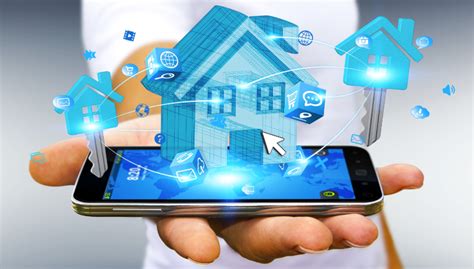Smart home automation: Enhancing energy efficiency
In today’s modern world, smart home automation is becoming increasingly popular among homeowners. This technology allows for the control and automation of various household systems, such as lighting, heating, and security, to enhance energy efficiency and provide convenience. By integrating smart devices and systems into our homes, we can not only reduce our energy consumption but also contribute to the overall sustainability of our planet.
One of the primary benefits of smart home automation is its ability to optimize energy usage. With the use of smart thermostats, for example, homeowners can regulate the temperature of their homes based on their preferences and patterns. These devices can also learn from our behaviors and adjust the temperature accordingly, further maximizing energy efficiency. Additionally, smart lighting systems can be programmed to turn on and off automatically, reducing unnecessary energy consumption when rooms are not occupied.
Another aspect of smart home automation that enhances energy efficiency is the ability to monitor and control energy-consuming appliances remotely. By connecting appliances such as refrigerators, washing machines, and dishwashers to a smart home system, users can easily track their energy usage and make adjustments to minimize waste. Smart home automation also offers the convenience of scheduling when these appliances should run, ensuring more energy-conscious usage during off-peak hours.
- Energy-efficient appliances: By investing in energy-efficient appliances, homeowners can significantly reduce their carbon footprint and contribute to a greener environment. These appliances are designed to use less energy while maintaining their functionality and performance.
- Smart lighting: Integrated lighting systems not only offer convenience but also optimize energy consumption. They can be controlled remotely and programmed to automatically adjust brightness levels based on natural light availability and occupancy.
- Energy monitoring: Smart home automation allows users to monitor their energy consumption in real-time through mobile apps or web interfaces. This visibility enables homeowners to identify energy-intensive areas and make necessary modifications to enhance efficiency.
| Benefits of Smart Home Automation for Energy Efficiency |
|---|
| – Reduced energy consumption |
| – Increased convenience and comfort |
| – Lower utility bills |
| – Minimized environmental impact |
Smart home automation has the potential to revolutionize the way we use energy in our homes. By incorporating this technology, we can reduce our carbon footprint, conserve energy resources, and create a more sustainable future. Moreover, the convenience and comfort offered by smart home automation make it an attractive option for homeowners looking to enhance their living spaces while contributing to a greener environment.
Solar power integration: Harnessing sustainable energy
Solar power integration refers to the process of incorporating solar panels or solar energy systems into existing infrastructures to harness clean and renewable energy from the sun. This technology has gained significant attention in recent years due to its numerous advantages and potential for reducing carbon emissions. By utilizing solar power, we can not only decrease our reliance on fossil fuels but also contribute to a greener and more sustainable future.
One of the key benefits of solar power integration is its ability to generate electricity without producing harmful greenhouse gas emissions. Unlike traditional energy sources such as coal or natural gas, solar panels use photovoltaic cells to convert sunlight directly into electricity. This means that solar power can be harnessed without releasing carbon dioxide or other pollutants into the atmosphere, helping to mitigate climate change and improve air quality.
Furthermore, solar power integration offers significant cost savings in the long run. While the initial installation cost of solar panels may be higher compared to traditional power generation methods, the operational and maintenance expenses are significantly lower. Once installed, solar panels require minimal upkeep, and the sunlight needed for energy production is freely available. This can lead to substantial savings on electricity bills, especially in areas with abundant sunlight.
- Solar power integration reduces reliance on fossil fuels.
- It helps mitigate climate change and improve air quality.
- Solar energy offers long-term cost savings.
| Advantages | Disadvantages |
|---|---|
| Sustainable and renewable | Dependent on sunlight availability |
| Reduces carbon emissions | Requires initial investment |
| Low operational costs | Space requirements for installation |
Energy-efficient appliances: Reducing carbon footprint
Energy-efficient appliances play a crucial role in reducing our carbon footprint and mitigating the effects of climate change. As we strive to become more environmentally conscious, it is important to understand the impact that our daily activities, such as using appliances, have on the environment. By using energy-efficient appliances, we can significantly reduce our energy consumption and hence our carbon emissions.
One of the key benefits of energy-efficient appliances is their ability to consume less electricity while providing the same level of functionality as their conventional counterparts. The technology used in these appliances allows them to operate at higher efficiency levels, converting more energy into useful work and minimizing wastage. This translates into reduced electricity bills for consumers and a significant reduction in greenhouse gas emissions.
When it comes to choosing energy-efficient appliances, there are several factors to consider. First and foremost is the energy efficiency rating, which is often displayed on the appliance itself. Look for appliances with high energy star ratings as these indicate that the appliance meets strict energy efficiency standards. Additionally, consider the size and capacity of the appliance. Larger appliances tend to consume more energy, so choose the size that suits your needs to avoid unnecessary wastage. Finally, consider the specific features of the appliance that contribute to energy efficiency, such as programmable settings, smart sensors, and energy-saving modes.
- Energy-efficient appliances provide significant savings on electricity bills.
- They reduce carbon emissions and help combat climate change.
- Choosing appliances with high energy star ratings is important.
- Consider the size and capacity of the appliance to avoid unnecessary energy consumption.
- Look for specific features that contribute to energy efficiency.
| Appliance | Energy Consumption (Old Model) | Energy Consumption (Energy-efficient Model) | Energy Savings |
|---|---|---|---|
| Refrigerator | 2000 kWh/year | 500 kWh/year | 1500 kWh/year |
| Washing Machine | 500 kWh/year | 200 kWh/year | 300 kWh/year |
| Dishwasher | 800 kWh/year | 300 kWh/year | 500 kWh/year |
By investing in energy-efficient appliances, not only do we contribute to reducing carbon emissions, but we also save money in the long run. The energy savings achieved through the use of these appliances can be significant, especially when considering their lifespan. It is important to recognize the role that each individual can play in reducing their carbon footprint, and opting for energy-efficient appliances is an effective and practical way to do so. Let’s make a conscious effort to choose energy efficiency and take steps towards a more sustainable future.
Water-saving solutions: Conserving a precious resource
Water-saving solutions are becoming increasingly important as we strive to conserve this precious resource. With rising concerns about water scarcity and the environmental impact of excessive water usage, it is crucial for individuals and communities to adopt efficient practices and technologies to reduce water wastage.
One effective method of conserving water is through the use of low-flow fixtures. Installing low-flow faucets, showerheads, and toilets can significantly reduce water consumption without compromising on functionality. These fixtures are designed to limit water flow while maintaining adequate water pressure, resulting in substantial water savings over time.
Another way to conserve water is by implementing smart irrigation systems. Traditional irrigation methods often lead to overwatering, but smart irrigation systems utilize sensors and weather data to adjust watering schedules based on specific water requirements. By delivering the right amount of water precisely when and where it is needed, these systems can prevent wastage and promote healthier plant growth.
Additionally, rainwater harvesting is an excellent water-saving solution. Collecting rainwater allows us to harness natural precipitation and use it for various non-potable purposes such as watering gardens, flushing toilets, and washing vehicles. By utilizing rainwater instead of relying solely on freshwater sources, we can reduce the strain on water supplies and conserve this valuable resource.
Moreover, simple yet effective behavioral changes can contribute to water conservation efforts. For instance, turning off the tap while brushing teeth, fixing leaky faucets promptly, and only running the dishwasher or washing machine with full loads can make a significant difference in water usage. Ensuring that everyone in a household or community is educated about the importance of water conservation and actively participates in these practices is crucial.
Implementing water-saving solutions is not only environmentally responsible but also financially beneficial. Conserving water can lead to reduced water bills, making it a win-win situation for both individuals and the community. By adopting these water-saving measures, we can make significant strides towards preserving our most valuable and finite resource.
List of water-saving solutions:
- Low-flow fixtures: Install low-flow faucets, showerheads, and toilets.
- Smart irrigation systems: Utilize sensors and weather data to optimize watering schedules.
- Rainwater harvesting: Collect and use rainwater for non-potable purposes.
- Behavioral changes: Turn off taps when not in use and fix leaks promptly.
Table showcasing water-saving solutions:
| Solution | Description |
|---|---|
| Low-flow fixtures | Install water-efficient faucets, showerheads, and toilets to reduce water consumption. |
| Smart irrigation systems | Use sensor-based systems that adjust watering schedules based on weather conditions, ensuring optimal water usage. |
| Rainwater harvesting | Collect rainwater and utilize it for non-potable purposes, reducing reliance on freshwater sources. |
| Behavioral changes | Adopt water-saving habits such as turning off taps when not in use, fixing leaks, and using appliances efficiently. |
Waste management systems: Reducing environmental impact
In today’s world, waste management has become a critical issue that needs urgent attention. The exponential increase in population and industrialization has led to an increase in waste production, posing a significant threat to the environment. However, with the advancement of technology, waste management systems have been developed to tackle these challenges and reduce the environmental impact. These systems aim to promote waste reduction, recycling, and proper disposal methods, ultimately contributing to a cleaner and more sustainable future.
One of the key goals of waste management systems is to minimize the amount of waste that ends up in landfills. This is achieved through various strategies such as waste segregation, composting, and recycling. Waste segregation involves sorting waste into different categories such as organic, recyclable, and non-recyclable, making it easier to manage and treat each type accordingly. Composting, on the other hand, is the process of decomposing organic waste into nutrient-rich compost, which can be used as natural fertilizer for gardens and farms.
Another important aspect of waste management systems is recycling. Recycling involves the collection and processing of certain materials, such as paper, plastics, glass, and metals, to create new products. By recycling, we can conserve natural resources, reduce the energy required for manufacturing, and minimize the environmental impact associated with extracting raw materials. It is crucial for individuals, businesses, and industries to actively participate in recycling initiatives to ensure the success of waste management systems.
- Waste reduction: Waste management systems place a strong emphasis on waste reduction. This can be achieved through practices such as implementing packaging alternatives, promoting reusable products, and encouraging responsible consumption. By reducing the amount of waste generated, we can significantly decrease the burden on our environment and conserve valuable resources.
- Proper disposal methods: Proper disposal of waste is essential to prevent pollution and contamination of air, water, and soil. Waste management systems educate people on the importance of following correct disposal methods, such as using designated waste bins, avoiding illegal dumping, and utilizing specialized facilities for hazardous waste. These measures help minimize the negative impact of waste on the environment and human health.
- Public awareness and education: To ensure the effectiveness of waste management systems, it is vital to raise public awareness and provide education on waste management practices. This includes informing individuals about the importance of recycling, proper waste segregation, and the consequences of improper waste disposal. By empowering individuals with knowledge, we can foster a culture of responsible waste management and encourage sustainable habits.
| Advantages of Waste Management Systems |
|---|
| 1. Environmental protection and preservation |
| 2. Resource conservation |
| 3. Energy production through waste-to-energy technologies |
| 4. Reduction of greenhouse gas emissions |
| 5. Creation of job opportunities in waste management sector |
By implementing effective waste management systems, we can significantly reduce the environmental impact of waste and move towards a sustainable future. It requires individuals, communities, businesses, and governments to work together in adopting responsible waste management practices and embracing the concept of a circular economy. The benefits are immense, ranging from environmental preservation to resource conservation and the creation of a healthier planet for future generations.
Smart gardening: Maximizing green spaces
Green spaces, such as gardens and parks, play a crucial role in maintaining the ecological balance of our planet. In today’s fast-paced world, where urbanization is at its peak, it is becoming increasingly important to find innovative ways to maximize green spaces. One such way is through smart gardening. By incorporating technology and sustainable practices, smart gardening allows us to create and maintain lush green spaces even in limited areas.
One of the key aspects of smart gardening is optimizing water usage. With water scarcity becoming a pressing issue, it is imperative to conserve this precious resource. Smart irrigation systems can be installed to ensure water is used efficiently. These systems can be programmed to water the plants at specific times and adjust the amount of water based on rainfall data or soil moisture sensors. By utilizing technology, we can avoid over-watering and minimize wastage, ultimately aiding in water conservation.
Another important aspect of smart gardening is utilizing vertical spaces. In urban areas, where horizontal space is limited, vertical gardening allows us to make the most of every available area. Hanging planters, green walls, and trellises are all excellent ways to maximize the use of vertical space. Not only does vertical gardening provide more room for plants, but it also adds visual appeal to any environment, be it home gardens or office spaces.
Furthermore, smart gardening involves the use of technology to monitor and maintain the health of plants. Plant sensors can be installed to keep track of temperature, humidity, and soil conditions. This data can then be analyzed to provide real-time insights and alerts, allowing us to take timely actions such as adjusting watering schedules or applying appropriate fertilizers. By closely monitoring the needs of plants, we can ensure optimal growth and minimize the risk of diseases or pests.
To further promote the idea of smart gardening, it is essential to educate and engage the community. Workshops, seminars, and online resources can be utilized to raise awareness about the benefits of smart gardening and provide practical tips for implementation. In addition, community gardening initiatives can be encouraged, where individuals come together to transform unused spaces into vibrant green areas. These initiatives not only help maximize green spaces but also foster a sense of communal harmony and pride.
In conclusion, smart gardening offers a sustainable and efficient solution to maximize green spaces in urban environments. By incorporating technology, optimizing water usage, utilizing vertical spaces, and promoting community engagement, we can create and maintain lush green areas that enhance the quality of life for both humans and the environment. Embracing smart gardening practices today will not only beautify our surroundings but also contribute to a greener and healthier future.
Air quality monitoring: Promoting a healthy environment
Air quality monitoring plays a crucial role in promoting a healthy environment. With the increasing levels of air pollution, it is essential to have systems in place that measure and analyze the quality of air we breathe. The quality of indoor and outdoor air affects our overall well-being and can have long-term implications on our health. By incorporating air quality monitoring systems, we can take proactive measures to minimize risks and make informed decisions to improve air quality.
One of the significant benefits of air quality monitoring is identifying and mitigating potential health hazards. Monitoring systems can detect pollutants and harmful substances in the air, such as volatile organic compounds (VOCs), carbon monoxide, and particulate matter. By identifying these pollutants, we can implement appropriate measures to reduce exposure and prevent health issues such as respiratory problems, allergies, and asthma.
Another advantage of air quality monitoring systems is their ability to provide real-time data and alerts. These systems use sensors and advanced technologies to continuously monitor the air quality parameters, such as pollutant levels, humidity, and temperature. They can send notifications and alerts if the air quality falls below acceptable standards, enabling us to take immediate action and make necessary adjustments to improve the air quality.
- Air quality monitoring systems help in identifying pollutants.
- They provide real-time data and alerts.
- Monitoring air quality promotes a healthy environment.
| Benefits of Air Quality Monitoring | Examples of Air Pollutants |
|---|---|
| Identifying and mitigating health hazards | Carbon monoxide, volatile organic compounds (VOCs) |
| Real-time data and alerts | Particulate matter, humidity, temperature |
| Prevention of respiratory problems and allergies | Nitrogen dioxide, ozone |
In addition to monitoring indoor air quality, it is equally important to assess the air quality in outdoor environments. By monitoring outdoor air quality, we can identify pollution sources and take necessary actions to reduce emissions and prevent the spread of pollutants. This includes monitoring emissions from industries, vehicles, and other sources that contribute to air pollution.
In conclusion, air quality monitoring is essential for promoting a healthy environment. By detecting pollutants, providing real-time data, and enabling proactive measures, these systems play a significant role in minimizing health risks and creating cleaner and safer surroundings. Whether it is monitoring air quality in homes, offices, or public spaces, the benefits of air quality monitoring are undeniable in our journey towards a healthier and sustainable future.
Smart lighting: Optimizing energy consumption
Smart lighting is a revolutionary technology that is changing the way we illuminate our homes and public spaces. It not only enhances the convenience and comfort of our daily lives but also plays a crucial role in optimizing energy consumption. By using advanced sensors, wireless controls, and energy-efficient LED bulbs, smart lighting systems are able to provide the right amount of light when and where it is needed, thereby reducing energy waste and saving money on electricity bills.
One of the key features of smart lighting is its ability to adjust the brightness and color temperature of the lights based on the time of day and natural light conditions. This not only creates a cozy and welcoming atmosphere but also helps to regulate our body’s internal clock, promoting better sleep and overall well-being.
Additionally, smart lighting systems can be integrated with other smart devices and connected to a central hub or controlled through a mobile app. This allows users to easily customize and automate their lighting preferences according to their needs and preferences. For example, lights can be programmed to turn on and off automatically when someone enters or leaves a room, or to gradually dim or brighten based on the time of day.
- Improved energy efficiency: Smart lighting systems use LED bulbs, which are up to 80% more energy-efficient than traditional incandescent bulbs. This translates into significant energy savings and a reduced carbon footprint.
- Cost savings: By optimizing energy consumption and reducing wasted electricity, smart lighting helps to lower energy bills and save money in the long run.
- Enhanced convenience and control: With smart lighting, users have the ability to control their lights remotely and customize their lighting preferences with ease, creating a more convenient and personalized lighting experience.
- Longer lifespan: LED bulbs used in smart lighting systems have a longer lifespan compared to traditional bulbs, reducing the frequency of bulb replacements and contributing to less waste.
| Smart Lighting Solutions | Key Features |
|---|---|
| Motion sensors | Detects movement and turns on/off lights accordingly, reducing energy waste in unoccupied areas. |
| Dimming capabilities | Allows users to adjust the brightness of lights to create the desired ambiance and reduce energy consumption. |
| Scheduling and automation | Enables users to program lights to turn on/off at specific times or in response to certain events. |
| Energy monitoring | Provides real-time data on energy usage, allowing users to identify patterns and make informed decisions to reduce energy waste. |
In conclusion, smart lighting offers numerous benefits when it comes to optimizing energy consumption. By using advanced technologies and features such as motion sensors, dimming capabilities, scheduling, and energy monitoring, smart lighting systems provide a more energy-efficient and customizable lighting experience. With the ability to reduce energy waste, save money, and contribute to a greener environment, smart lighting is undoubtedly a smart choice for anyone looking to optimize their energy consumption.
Frequently Asked Questions
Question 1: How can smart home automation enhance energy efficiency?
Smart home automation can enhance energy efficiency by allowing homeowners to control and automate various energy-consuming devices and systems, such as HVAC, lighting, and appliances. Through sensors and programmable settings, smart home automation can optimize energy usage, reduce wastage, and help homeowners make informed decisions about their energy consumption.
Question 2: What are the benefits of integrating solar power into a smart home?
Integrating solar power into a smart home has several benefits. It harnesses sustainable energy, reducing dependence on fossil fuels and lowering greenhouse gas emissions. Solar power integration can also lead to substantial cost savings on electricity bills and potentially generate revenue through net metering. Additionally, it allows homeowners to become more self-sufficient and have a reliable backup power source during grid outages.
Question 3: How do energy-efficient appliances contribute to reducing carbon footprint?
Energy-efficient appliances consume less electricity compared to standard appliances, resulting in reduced carbon emissions from power plants. These appliances are designed to use energy more efficiently, incorporating technologies such as improved insulation, advanced cooling systems, and smart power management. By using energy-efficient appliances, homeowners can actively contribute to reducing their carbon footprint and promote sustainable living.
Question 4: What are some effective water-saving solutions for a smart home?
There are several water-saving solutions for a smart home. Installing smart sprinkler systems that adjust watering schedules based on weather conditions and soil moisture levels can minimize water wastage. High-efficiency faucets, showerheads, and toilets can also reduce water consumption. Additionally, using leak detection sensors and smart water meters can help identify and rectify water leaks promptly, preventing unnecessary water loss.
Question 5: How can waste management systems in smart homes reduce environmental impact?
Waste management systems in smart homes enable efficient separation, recycling, and disposal of waste materials. Smart waste bins equipped with sensors can optimize waste collection routes, reducing fuel consumption and greenhouse gas emissions from garbage trucks. By promoting proper waste management practices, smart homes can significantly reduce environmental pollution, conserve resources, and contribute to sustainable waste management efforts.
Question 6: What are the benefits of smart gardening in maximizing green spaces?
Smart gardening utilizes technology to optimize the use of green spaces and promote sustainable gardening practices. Through soil moisture sensors, weather monitoring, and automated irrigation systems, smart gardening ensures plants receive the right amount of water at the right time, minimizing water wastage. Additionally, smart gardening systems can provide valuable insights into plant health, pest control, and optimal planting techniques, leading to healthier and more productive gardens.
Question 7: How does air quality monitoring in smart homes promote a healthy environment?
Air quality monitoring in smart homes helps homeowners track and optimize indoor air quality. By monitoring pollutants, humidity levels, and ventilation, smart systems can provide real-time data and alerts, allowing homeowners to take necessary actions, such as adjusting HVAC settings or using air purifiers. This promotes a healthy living environment, reduces the risk of respiratory ailments, and enhances overall well-being.





